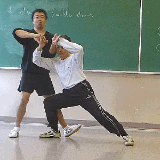 On another Fall Ottawa weekend, Rachel, James and Daniel of the Ottawa Practical Methods Group organized an intensive training seminar with Ronnie Yee, one of Master Joseph Chen’s Senior Disciples. For two days, students of the Practical Method in the Ottawa Region as well as Hugo from the Toronto group, enjoyed the stories and instructions from Ronnie.
On another Fall Ottawa weekend, Rachel, James and Daniel of the Ottawa Practical Methods Group organized an intensive training seminar with Ronnie Yee, one of Master Joseph Chen’s Senior Disciples. For two days, students of the Practical Method in the Ottawa Region as well as Hugo from the Toronto group, enjoyed the stories and instructions from Ronnie.
The organizers would like to thank Master Joseph Chen, Ronnie Yee, all of the participants and the Ottawa Tai Chi Chuan Association for their contributions to the success of this seminar. The following is my summary and personal observations.
Outline of the seminar
For two days, Ronnie explained the details of the Practical Method. Using the positive circle and negative circle as the guiding principle, Ronnie taught us to apply the basic rules of the Practical Method to all aspects of the training including an elucidation of the eight energies of Taijiquan. For every move, he explained the importance of creating the initial vertical axis in the spine, then the horizontal axis in the kua and maintaining the forty-five angle towards your opponent. Those rules are applied strictly – from the foundation methods, to each movement within the form, from training with your partners to free form (push hands), there are no exceptions and deviations. The effectiveness of the Practical Method depends on how closely you conformed to those rules. Sparring in the Practical Method is a physical chess match, the winner is the person who cause his opponents to violate those rules.
Who is Ronnie?
Ronnie Yee is a martial arts instructor by training, a massage therapist by profession and a magician by interest. Raised in Regina, Sask., Canada, he is the first official disciples of Master Joseph Chen Zhonghui when the Master decided to dedicate his life to the teaching of the traditional martial arts. Ronnie has traveled the long and winding path of the martial artists. He had practiced wushu, praying mantis and many other internal and external martial arts. In addition, he continued to exchange ideas and techniques with others within the martial arts community. Since becoming the disciple of Master Chen, Ronnie has dedicated his time to the understanding of the Practical Method. An example of the young Ronnie can be seen in this video of push hand demonstration in China in 2001.
What is more revealing is a personal interview of his thought and ideas in 2004 during his fifth trip to China with Master Chen. From his interview, you can see the consistency in his philosophy and his approach to the martial arts. Even after ten years, his view point has not changed – only his understanding and skills has improved considerably.
Ronnie had generally kept a low profile in Regina and trained mainly with his students. Recently, he has moved to the Vancouver area and has began to offer seminars and workshops on the Practical Method. For example, his recent workshop in Vancouver was met with great success. The lessons Ronnie taught in Ottawa shows that he is a valuable resource in helping Taijiquan practitioners comprehend the intricacy of the Practical Method.
Slow is not the secret; Precision is the key
Slow movements are considered to be one of the key attributes of Taijiquan practice. Even when Grandmaster Chen Fake first arrived in Beijing, his form was criticized for being too fast. This belief in slowness even extends to applications so that Taijiquan practitioners will claim that the “slow can overcome the fast” without understanding what this really means.
As Ronnie pointed out during the seminar. Slow is not the secret to Taijiquan effectiveness but precision and accuracy is the key to Taijiquan success. In the Practical Method, you train so that each move is the same. Externally, this means the movement starts and ends at the same point and travel through the same path. Internally, this means each movement must conform to the basic rules of Taijiquan with no deviation. You repeat until this movement can be performed at any speed. The students of Grandmaster Hong said that his form looked the same through out his life. If you check the videos of Master Joseph Chen through the years, you can also see the consistency of his form. During the seminar, Ronnie also demonstrated this quality. Each movement starts with a fixed point, travel through a path dictated by the rules of Taijiquan and ends naturally.
This focus on precision and accuracy is the reason why performing Yilu according to the Practical Method is often described as “laying down tracks”. The tracks referring to both the physical and more importantly the energy path of the movement. Train tracks once laid does change or deviate; it becomes useless if there is even a slight misalignment. As Ronnie demonstrated, once the tracks are laid, the cannon fist form showed how to used those tracks.
Avoid conflict; Rotate into spirals
As students of the Practical Method, spirals are the key in any application. Ronnie demonstrate the importance of creating the spiral with the back hand as an opponent attacks from the front.
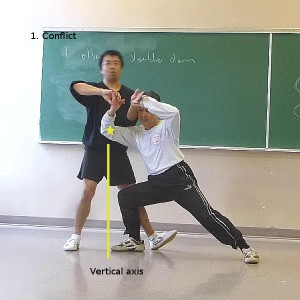 |
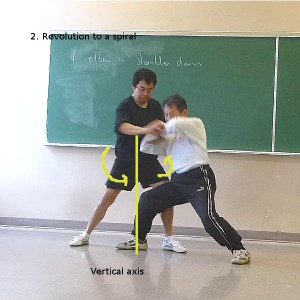 |
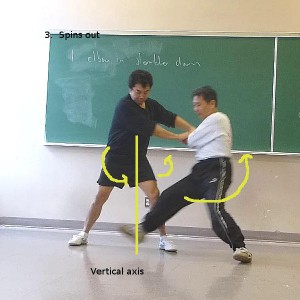 |
| Figure 1 | Figure 2 | Figure 3 |
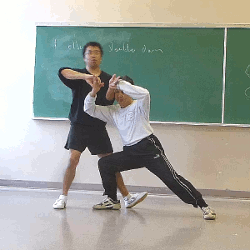 In Figure 1, the opponent creates a conflict with an elbow strike.
In Figure 1, the opponent creates a conflict with an elbow strike.
In Figure 2, Ronnie maintains the integrity of his vertical axis and resolves the conflict with a revolution that turns into a spiral. In Figure 3, the opponent spins out of the vertical axis. Figure 4 is a representative animation of this sequence.
Grandmaster Hong described the essences of the Practical Method as:
運纏法, Use the method of chan (silk reeling)
不丟頂; But don’t retreat or fight head on
引進身, Entice your opponent’s body
使落空; To make him fall into emptiness.
Those concept was clearly demonstrated by Ronnie.
Find the elusive spot and wait
I asked Ronnie how does he train. He said that he is focusing on finding the elusive spot. This is a concept that has often been described by Master Chen as well. Ronnie provided the following illustration of finding the dot.
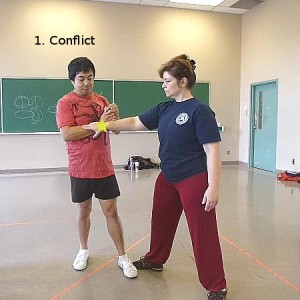
|
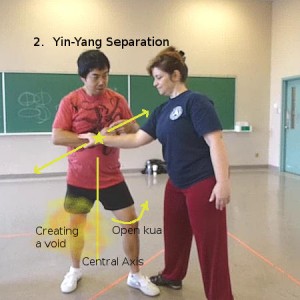
|
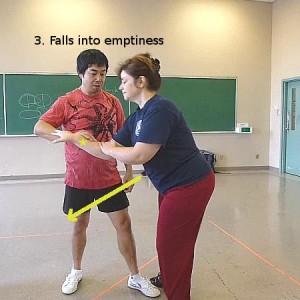
|
| Figure 5 | Figure 6 | Figure 7 |
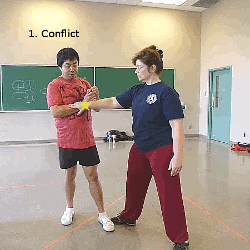 In Figure 5, the instant that an opponent grabs you, a conflict appears. At this point of conflict, a dot is created. In Figure 6, the Practical Method practitioner does not continue the conflict but resolves the conflict via the process of Yin-Yang separation. Following the rules of Taiji, the dot does not move, energy is split forwards and backwards along a energy path. Maintaining the vertical axis, the structure of body is changed by opening one of the kua. The opponent feels a void has been created. In Figure 7, the opponent moves because she falls into emptiness. Figure 8 is an animation of this sequence.
In Figure 5, the instant that an opponent grabs you, a conflict appears. At this point of conflict, a dot is created. In Figure 6, the Practical Method practitioner does not continue the conflict but resolves the conflict via the process of Yin-Yang separation. Following the rules of Taiji, the dot does not move, energy is split forwards and backwards along a energy path. Maintaining the vertical axis, the structure of body is changed by opening one of the kua. The opponent feels a void has been created. In Figure 7, the opponent moves because she falls into emptiness. Figure 8 is an animation of this sequence.
The instructions of Master Chen and Ronnie does not deviate from the words of Grandmaster Hong:
嚴守規矩, Follow the rules strictly,
潛化默通; Through osmosis, you will be enlightened.
心手兩望, The heart and the hand will both be forgotten.
自合準繩。 At this time, you and the rules are one.
Traditional Martial Arts training in a Modern World
Previously, I have said “To find a good teacher, first look to his students”. Ronnie is a proof for this approach. Since becoming the disciple of Master Chen, Ronnie has trained diligently to achieve success in the Practical Method. I have previously raved about the skills of Master Chen. I can also attested to the martial arts ability of Ronnie. During some friendly exchanges, Ronnie showed me some of the magic of the Practical Method.
Over the two days, Ronnie was quite open to questions concerning his martial arts experience. Just like many martial arts enthusiasts, Ronnie has traveled the world seeking the essence of martial arts. Initially, he tested his martial arts skills against anyone even Master Chen. Even after training in the Practical Method, he would still maintain his interest in other martial arts. After meeting many masters in China and across North America, he could not find anything that matches his experience with the Practical Method. Ronnie confessed that in the early 2000’s, he experienced some doubt in his training. The ability of Master Chen and some of the other masters are without question. Doubt creeps in because the Practical Method training is so different from the conventional martial arts curriculum.
I asked Ronnie how he got over this doubt. His present ability clearly showed he had made significant progress in the art. What is the secret? Ronnie explained that he just read Master Chen’s translation of Hong’s writings and trained according to those Taiji principles. This is the real traditional martial arts training in this modern world – focus on the principles; ignore the noise.
I always look back on Grandmaster Hong’s words and find some succinct truths that can serve as guidance for any student. During the moment of doubt, when you question your own dedication to the art, remember the following:
由感性, From physical understanding,
而理性, To mental understanding
多思考, Contemplate frequently
多練習, Practice regularly
持之恒, Persist
守規矩, Follow the rules
求進步, Seek progress
莫心急, Don’t rush
Master Chen and Ronnie showed that this Taijiquan is a real martial art and could be learned via the Practical Method. Seminars and training with your friends are important aspects in learning this art.


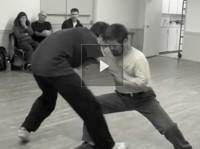
{ 7 comments… read them below or add one }
Very nice review Ming, Thanks for sharing.
Ming, you always post such great reviews. Love your articles. Keep up the good work.
Thank you Ming Tam! It is a great writeup, expressing everything perfectly. It reflects all our desires, our practice, our occasional doubts, and identifies the magic that keeps us happily plugging along. Great to see success that motivates us to work steadily forward! Thank you also for making all those connections between what is happening and what have been recorded in generations past. Bravo, Ming! I’m more motivated than ever just by reading your article.
Great review Ming! It was absolutely tremendous to have an opportunity to train under Ronnie Yee, from all angles a true part of the Practical Method transmission. An inspiring weekend seminar experience that I hope to have the privilege of repeating in the future.
001 is in perfect position to help spread Master Chen’s Practical Method. Good move to Vancouver from Regina, Ronnie.
Yes, I agree. He can be a multiplier factor for Chen Zhonghua Laoshi’s teachings and spread of the Practical Method globally. Thank you very much to Ronnie for teaching important details to all workshop participants. Good teacher. As a consequence, we have all improved for the better.
After learning the principles and the techniques, improving precision is the key, just like what 001 says. A Taiji manuscript also says: ‘Improve the precision first by the meter, then by decimeter, then by centimeter, then by millimeter. (metric units used here for clarity)’ You and I may need the opponent to have 60-40 imbalance in order for a technique to work while 001 would be looking for 51-49 or even 50.1-49.9 imbalance. That’s why a technique always works for him but not for you and me.